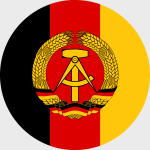Hobby Master HA6514 East German Mikoyan Gurevich MiG-29A 'Fulcrum' Fighter - "Red 661", (LSK-NVA), Germany, 1990 (1:72 Scale)
"Were the Soviet Union to sink tomorrow under the waters of the ocean, the American military-industrial establishment would have to go on, substantially unchanged, until some other adversary could be invented. Anything else would be an unacceptable shock to the American economy."
- George Frost Kennan, American advisor, diplomat, political scientist, and historian, best known as "the father of containment" and as a key figure in the emergence of the Cold War
 The Mikoyan MiG-29 (NATO reporting name: Fulcrum) is a twin-engine jet fighter aircraft designed in the Soviet Union. Developed by the Mikoyan design bureau as an air superiority fighter during the 1970s, the MiG-29, along with the larger Sukhoi Su-27, was developed to counter new U.S. fighters such as the McDonnell Douglas F-15 Eagle and the General Dynamics F-16 Fighting Falcon. The MiG-29 entered service with the Soviet Air Forces in 1982.
The Mikoyan MiG-29 (NATO reporting name: Fulcrum) is a twin-engine jet fighter aircraft designed in the Soviet Union. Developed by the Mikoyan design bureau as an air superiority fighter during the 1970s, the MiG-29, along with the larger Sukhoi Su-27, was developed to counter new U.S. fighters such as the McDonnell Douglas F-15 Eagle and the General Dynamics F-16 Fighting Falcon. The MiG-29 entered service with the Soviet Air Forces in 1982.
While originally oriented towards combat against any enemy aircraft, many MiG-29s have been furnished as multirole fighters capable of performing a number of different operations, and are commonly outfitted to use a range of air-to-surface armaments and precision munitions. The MiG-29 has been manufactured in several major variants, including the multirole Mikoyan MiG-29M and the navalized Mikoyan MiG-29K; the most advanced member of the family to date is the Mikoyan MiG-35. Later models frequently feature improved engines, glass cockpits with HOTAS-compatible flight controls, modern radar and infrared search and track (IRST) sensors, and considerably increased fuel capacity; some aircraft have also been equipped for aerial refueling.
Following the dissolution of the Soviet Union, the militaries of a number of former Soviet republics have continued to operate the MiG-29, the largest of which is the Russian Air Force. The Russian Air Force wanted to upgrade its existing fleet to the modernized MiG-29SMT configuration, but financial difficulties have limited deliveries. The MiG-29 has also been a popular export aircraft; more than 30 nations either operate or have operated the aircraft to date. As of 2013 the MiG-29 was still in production by Mikoyan, a subsidiary of United Aircraft Corporation (UAC) since 2006.
Pictured here is a 1:72 scale replica of an East German MiG-29A Fulcrum multirole fighter from 1990. Sold Out!
Dimensions:
Wingspan: 9-1/2-inches
Length: 13-3/4-inches
Release Date: May 2022
Historical Account: "The Air Forces of the National People's Army" - The Air Forces of the National People's Army (German: Luftstreitkrafte der Nationalen Volksarmee; LSK) was the Air Force of East Germany. As with the Landstreitkrafte, the Volksmarine, and the Border Troops, it was a military branch of the National People's Army (NVA).
The name Luftstreitkrafte applied originally to the air corps of the German Empire between 1910 and the end of World War I in 1918. However, the West German Air Force adopted the name 'Luftwaffe' as used by the Third Reich's air force from 1935 to the end of World War II.
At the end of November 1953, a reorganization of air units saw air units transferred from the Ministry of the Interior directly to the Deputy Minister and Chief of the People's Police. The air regiments were reorganized into the Aero Club 1 (Cottbus), 2 (Drewitz) and 3 (Bautzen), which in turn were divided into two sections. Starting in 1954, additional Z-126 and M-1D from Czechoslovakian production were made available.
On March 1st, 1956, the air force was officially established as part of the National People's Army, following the GDR's entry into the Warsaw Pact alliance. Initially the air force (LSK), with its headquarters at Cottbus, was separate from the Luftverteidigung (Air Defence, headquartered at Strausberg. It was intended to establish three fighter divisions, an attack aircraft division and an anti-aircraft division. However, eventually only the 1st and 3rd Aviation Divisions and the 1st Flak-Division were created. On June 1st, 1957, there was a merger of the two administrations in Strausberg, and the new headquarters was renamed the Kommando LSK/LV.


